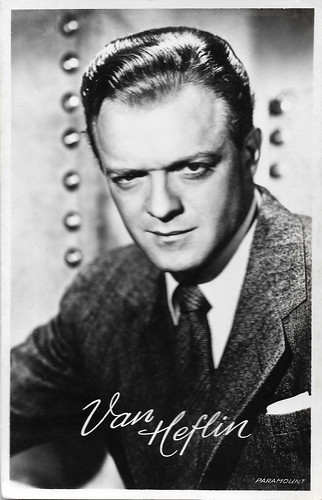
Vintage postcard, no. 3308. Photo: Paramount.
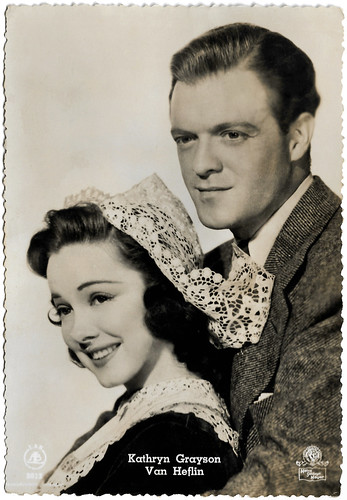
Belgian postcard by Les Editions d'Art L.A.B., Bruxelles (Brussels), no. 2012. Photo: Metro Goldwyn Mayer. Kathryn Grayson and Van Heflin in Seven Sweethearts (Frank Borzage, 1942).
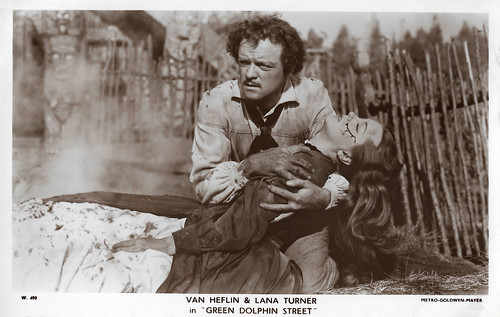
British postcard in the Picturegoer Series, London, no. W 490. Photo: M.G.M. Van Heflin and Lana Turner in Green Dolphin Street (Victor Saville, 1947).

Dutch postcard by Foto Archief Film en Toneel, no. 3454. Photo: M.G.M. Van Heflin, Gene Kelly, Gig Young, and Robert Coote in The Three Musketeers (George Sidney, 1948), based on the novel by Alexandre Dumas.
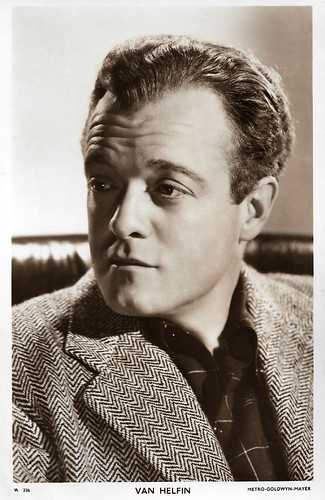
British postcard in the Picturegoer Series, London, no. W 336. Photo: Metro-Goldwyn-Mayer.
Drawn to life on the sea
Emmett Evan Heflin was born in 1908 in Oklahoma as the son of Fanny Bleecker (Shippey) and Emmett Evan Heflin, a dentist. He moved to his grandmother in California after his parents separated.
Drawn to life on the sea, Heflin shipped out on a tramp steamer upon graduating from high school, returning after a year to attend the University of Oklahoma in pursuit of a law degree. Two years into his studies, Heflin was back on the ocean.
Having entertained thoughts of a theatrical career since childhood, Heflin enrolled at the prestigious Yale School of Drama and made his Broadway bow credited as 'Evan Heflin' in Channing Pollock's 'Mister Moneypenny' (1928). When the play folded after 61 performances, Heflin once more retreated to the sea, sailing up and down the Pacific for nearly three years.
He revitalised his acting career in 1931, appearing in one short-lived production after another until landing a long-running assignment as a radical leftist at odds with the established elite in the S.N. Behrman comedy of manners Broadway play 'End of Summer' (1936). This led to his film bow in Katharine Hepburn's A Woman Rebels (Mark Sandrich, 1936), as well as a brief contract with RKO Radio. Katharine Hepburn requested Heflin's services once more for her Broadway play 'The Philadelphia Story', and while the 1940 MGM film version of that play cast James Stewart in Heflin's role, the studio thought enough of Heflin to sign him to a contract.
Van Heflin remained at MGM for eight years (1941-1949). During WWII he served in the US Army as a combat cameraman in the 9th Air Force in Europe. After serving in various Army film units, Heflin resumed his film career. He won the "Best Supporting Actor" Oscar for his third assignment at the studio, that of the alcoholic, Shakespeare-spouting best friend of Robert Taylor in Johnny Eager (Mervyn LeRoy, 1942). He was immediately cast in the leading role as a forensically-minded detective in Kid Glove Killer (1942), which marked the debut of Fred Zinnemann as a feature director.

Belgian postcard by Les Editions d'Art L.A.B., Bruxelles, no. 1508. Photo: Metro Goldwyn Mayer. Van Heflin in Seven Sweethearts (Frank Borzage, 1942).
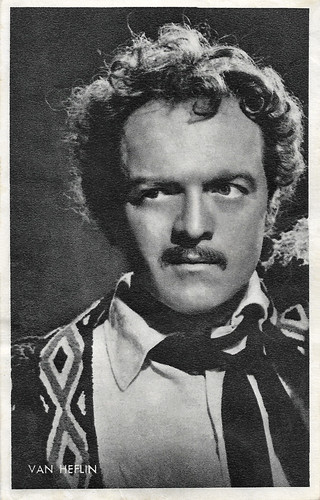
Belgian collectors card by Kwatta, Bois-d'Haine. Photo: M.G.M. Van Heflin in Green Dolphin Street (Victor Saville, 1947).
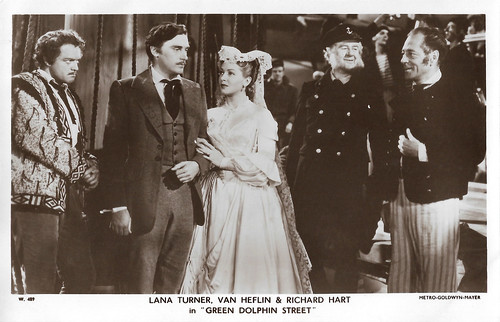
British postcard in the Picturegoer Series, London, no. W 489. Photo: M.G.M. Lana Turner, Van Heflin, Richard Hart and Reginald Owen in Green Dolphin Street (Victor Saville, 1947).

Dutch postcard by Fotoarchief Film en Toneel, no. 3453. Photo: Metro Goldwyn Mayer. Van Heflin in The Three Musketeers (George Sidney, 1948).
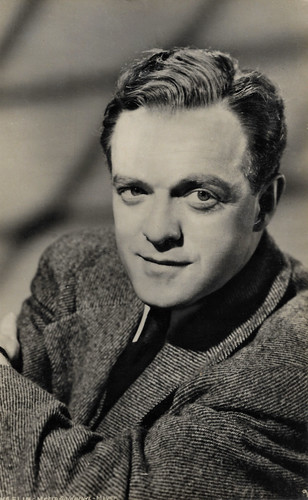
Spanish postcard, no. 5008.
The craggy-faced, dependable star character actor
In between wartime service and two musicals, Presenting Lily Mars (Norman Taurog, 1943) and the Jerome Kern biopic Till the Clouds Roll By (Richard Whorf, Vincente Minnelli, George Sidney, 1946), Van Heflin appeared in the excellent Film Noir The Strange Love of Martha Ivers (Lewis Milestone, 1946) with Barbara Stanwyck as the inevitable femme fatale and Kirk Douglas.
For a short while, he was heard on the radio as Raymond Chandler's philosophical private eye Philip Marlowe. He appeared as a jilted lover in the costume drama Green Dolphin Street (Victor Saville, 1947), he was Athos, one of The Three Musketeers (George Sidney, 1948) and he played an ex-GI on the trail of a psychopathic prison camp informer in Fred Zinnemann's Act of Violence (1948). Heflin was poignant as the unloved Monsieur Bovary in Madame Bovary (Vincente Minnelli, 1949). He also played a cop whose affair with a married woman led to a plot to kill her husband in The Prowler (Joseph Losey, 1951).
Throughout the 1950s, the craggy-faced, dependable star character actor worked in both Hollywood and Europe. I.S. Mowis at IMDb: "He is best remembered in this decade for his portrayal of Western characters with integrity and singularity of purpose: as the struggling homesteader at the mercy of a ruthless cattle baron who befriends Shane (George Stevens, 1953); the desperate, single-minded rancher trying to get a captured outlaw on the 3:10 to Yuma (Delmer Daves, 1957); and the tough, uncompromisingly stern father forced to kill his errant son in Gunman's Walk (Phil Karlson, 1958)."
In 1963, he was engaged to narrate the prestigious TV anthology The Great Adventure. He was forced to pull out of this assignment when cast as the Louis Nizer character in the Broadway play 'A Case of Libel'. He appeared in the calamitous flop The Greatest Story Ever Told (George Stevens, David Lean, Jean Negulesco, 1965) and the equally disastrous Stagecoach (Gordon Douglas, 1966) remake.
One of his last performances was as the deranged bomber in Airport (George Seaton, Henry Hathaway, 1970). Heflin's final film appearance was in the made-for-TV speculative drama The Last Child (John Llewellyn Moxey, 1971). Van Heflin died in 1971 of a heart attack at the age of 61. He was married twice, first to silent film star Esther Ralston, then to RKO contract player Frances Neal who should not be confused with Heflin's actress sister, Frances Heflin.
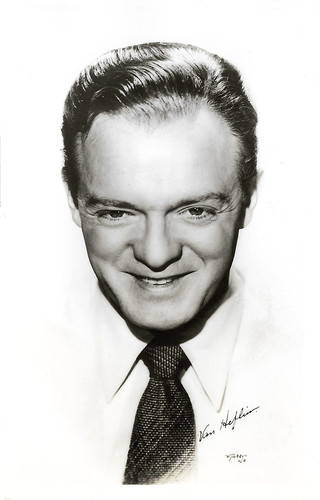
American postcard by W.J. Gray, Los Angeles. Photo: W.J. Gray.
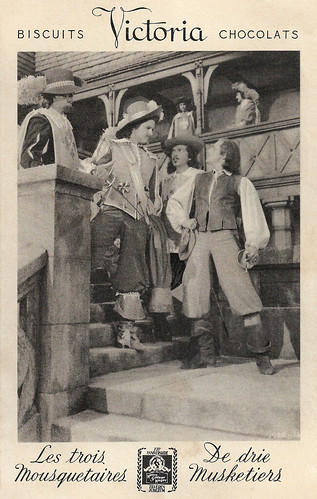
Belgian postcard by Victoria Biscuits Chocolats, no. 3. Photo: M.G.M. Van Heflin, Robert Coote, Gig Young, and Gene Kelly in The Three Musketeers (George Sidney, 1948), based on the novel by Alexandre Dumas.

Belgian postcard by Victoria Biscuits Chocolats, no. 4. Photo: M.G.M. Frank Morgan, Reginald Owen, Gene Kelly, Van Heflin, Gig Young, and Robert Coote in The Three Musketeers (George Sidney, 1948).

Belgian postcard by Victoria Biscuits Chocolats, no. 18. Photo: M.G.M. Van Heflin and Lana Turner in The Three Musketeers (George Sidney, 1948).
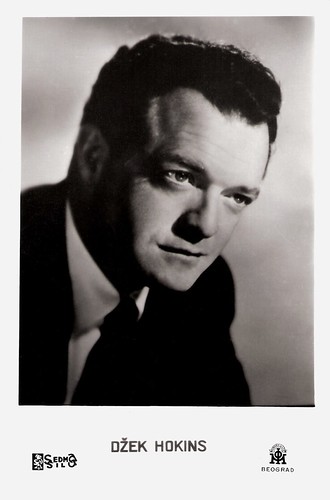
Yugoslavian postcard by Sedmo Silo / IOM, Beograd. The card mistakenly identifies him as Jack Hawkins.
Source: I.S. Mowis (IMDb), Hal Erickson (AllMovie - page now defunct), Wikipedia and IMDb.
This post was last updated on 1 September 2024.
No comments:
Post a Comment